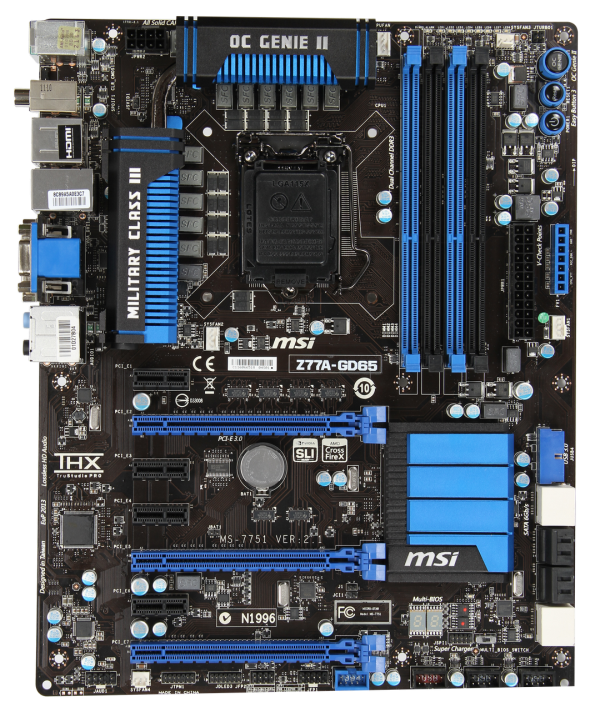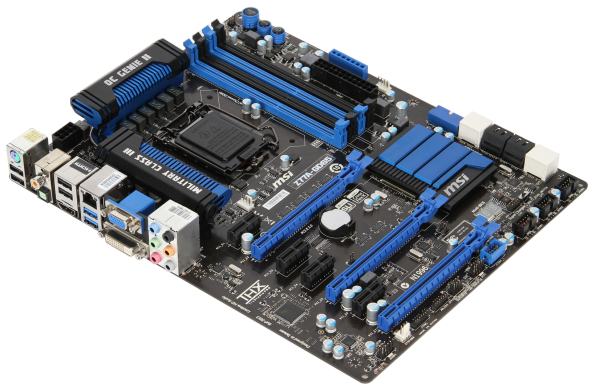Intel Z77 Panther Point Chipset and Motherboard Preview – ASRock, ASUS, Gigabyte, MSI, ECS and Biostar
by Ian Cutress on April 8, 2012 12:00 AM EST- Posted in
- Motherboards
- Intel
- Biostar
- MSI
- Gigabyte
- ASRock
- Asus
- Ivy Bridge
- ECS
- Z77
MSI Z77A-GD65—Visual Inspection
Whenever it comes to a motherboard comparison involving ASUS, Gigabyte or ASRock against an MSI board, the MSI board always tends to show a strong result—either in terms of price, performance or features. So when it comes to the new batch of motherboards for Ivy Bridge, it is fair to say that I expect a strong showing from MSI. For this preview, we have their Z77A-GD65, which will be one behind their future released GD80 that got attention back at CES for being Thunderbolt equipped.
The Z77A-GD65 is another motherboard in this roundup that comes in a black and blue livery. This time MSI have more of an excuse than others do as they have been using it for a fair while now. Using what is essentially a 10 + 2 phase power delivery, MSI are using somewhat beefier heatsinks than their rivals, connecting both via a heatpipe. The socket area is right up against Intel's minimum requirements from left to right, but there is some room to maneuver big air coolers from top to bottom. Around the socket there are at least four fan headers to use: one 4-pin CPU header between the top VRM and the memory slots, a 4-pin system fan header just the other side of the memory slots, a 4-pin to the bottom left of the socket area, and another 4-pin beside the 24-pin ATX power connector. A fifth fan header can be found at the bottom of the board.
Along the right hand side, we have the standard MSI trio of power/reset/OC Genie buttons, followed but a series of voltage checkpoints for overclockers. Aside from the 24-pin power connector and the system fan header, there is also a USB 3.0 header at right angles to the board, indicating its primary use is to the front of the case. Underneath this are the eight SATA ports—two SATA 6 Gbps from the PCH, four SATA 3 Gbps also from the PCH, and another two SATA 6 Gbps from an ASMedia controller.
As the power/reset/OC Genie buttons are at the top right, the bottom of the board has more room to fit in all the headers as needed—front panel audio, TPM, front panel headers and USB 2.0 headers. In terms of PCIe, MSI have done away with the PCIe to PCI bridge and focused purely on PCIe. We have an x1, x16 (x8 with dual GPU), x1, x1, x8, x1, and a PCIe 2.0 x4. In this instance, there is plenty of room for a dual GPU setup with PCIe slots to spare for any extras.
Also of note is the chipset cooler, which is very flat and large with minimal fins, perhaps suggesting that MSI is confident about their heatsink design. Underneath this is a two digit debug display, and a BIOS switch for changing between two BIOSes.
On the rear IO panel, I think MSI have been reasonable with what they have left in and what they have left out. From left to right, we have a combination PS/2 port, two USB 2.0 ports (black), a clear CMOS button, digital and coaxial SPDIF outputs, two more USB 2.0 ports (black), a HDMI port, gigabit Ethernet, two USB 3.0 ports (blue), D-Sub, DVI-D, and audio jacks.
Board Features
| MSI Z77A-GD65 | |
| Size | ATX |
| CPU Interface | LGA-1155 |
| Chipset | Intel Z77 |
| Power Delivery (CPU/iGPU) | 8 + 1 + 2 + 1 (VRM/VTT/GPU/SA) |
| Memory Slots |
Four DDR3 DIMM slots supporting up to 32 GB Up to Dual Channel, 1066-2667 MHz |
| Video Outputs | HDMI, DVI-D, D-Sub |
| Onboard LAN | Intel 82579V |
| Onboard Audio | Realtek ALC898 |
| Expansion Slots |
2 x PCIe x16 Gen3 (x16, x8/8) 1 x PCIe x16 Gen2 (x4) 4 x PCIe x1 Gen2 |
| Onboard SATA/RAID |
2 x SATA 6 Gbps (PCH), Support for RAID 0, 1, 5, 10 4 x SATA 3 Gbps (PCH), Support for RAID 0, 1, 5, 10 2 x SATA 6 Gbps (ASMedia ASM1061) |
| USB |
4 USB 3.0 ports (2 back panel, 2 from headers) 10 USB 2.0 ports (4 back panel, 6 from headers) |
| Onboard |
4 x SATA 6Gbps 4 x SATA 3 Gbps 1 x USB 3.0 Header 3 x USB 2.0 Headers 1 x IEEE1394 Header 1 x TPM Header 1 x Front Panel Audio Header Power/Reset Buttons OC Genie 5 x Fan Headers |
| Power Connectors |
1 x 24-pin ATX connector 1 x 8-pin 12V connector |
| Fan Headers |
1 x CPU Fan Header (4-pin) 4 x SYS Fan Headers (two 4-pin, two 3-pin) |
| IO Panel |
1 x Combo PS/2 Port 1 x Clear CMOS Button 1 x Coaxial S/PDIF Port 1 x Optical S/PDIF Port 4 x USB 2.0 2 x USB 3.0 1 x Gigabit Ethernet Audio Jacks 1 x HDMI 1 x DVI-D 1 x D-Sub |
| Warranty Period | 3 Years |
| Product Page | Link |
It is good to see an Intel NIC on this $180 MSRP motherboard. There are plenty of headers to go around. The only things missing where other motherboards may have better all-round functionality are a PCI slot, mSATA and on-board WiFi.













145 Comments
View All Comments
Springf - Sunday, April 8, 2012 - link
Quote: Native USB 3.0The other long awaited addition found on Panther Point is the native implementation of USB 3.0 that comes directly from the chipset. The chipset will only provide two USB 3.0 ports,
------- end quote
I think Z77 natively support 4 USB 3.0 ports
http://www.intel.com/content/dam/www/public/us/en/...
C'DaleRider - Sunday, April 8, 2012 - link
When you write sentences like this:"ASUS have a lot to live up to with its Ivy Bridge Pro board."
You do realize that you're mixing a plural verb and singular pronoun for the same damn thing...Asus in this case. First, you use a plural verb talking about Asus and then use a singular pronoun for Asus in the same sentence. You cannot do both; well, I guess you can, but you show you have no clue about English grammar and look like you dropped out of third grade.
Get a copy editor! How can anyone take this site a professional when the writing borders on illiterate?
sausagestrike - Sunday, April 8, 2012 - link
You should higher a sand removal specialist to take a look at you're twat.Arbie - Monday, April 9, 2012 - link
@C'DaleRider -You do realize that... you're the illiterate one, don't you?
"ASUS have" is perfectly legitimate English, and is in fact what you will hear in England itself. "ASUS" is a company of people and can be taken as singular or plural.
For me, the AT editors just made major points right in this set of comments by correcting another ignoramus, who was misusing "begs the question".
Now, can we get back to fan headers?
Iketh - Tuesday, April 10, 2012 - link
no, there are errors STILL all over the place in this article... it's horrid... when your site is 99% words, please make them as easy as possible to comprehend...PLEASE LEARN TO WRITE LIKE ANAND, THX!
Anand, for the love of god, pay a little more to hire a little more education (SEE WHAT I DID THAR??)
nz_nails - Monday, April 9, 2012 - link
"Biostar have unfortunately put much effort in here, with only three to play with..."Should be a "not" in there I suppose.
s1lencerman - Monday, April 9, 2012 - link
I do not understand why non express PCI slots are still on boards. The only one to see the light is MSI, and if they had a bit better performance I would switch from ASUS for my next mobo in a heartbeat. Also, why do these boards have a VGA connector (D-sub)? Intel HD graphics can only support 2 displays max, and if you have more than you should get a dedicated graphics card anyway, and probably already have. I don't see the point.Another thing, when will OEMs start putting the USB hub at the bottom of the board facing down and not away from the board. If you have multiple cards on the board then you can get really cramped really fast when you are trying to use those.
I'm sorely tempted to just wait another year or so till there is a board with these features and over 50% SATA 6G/s, but we'll see if that even comes out in that short of time.
DanNeely - Monday, April 9, 2012 - link
1) Some customers are asking for them. Customer demand was why a few boards started sporting floppy controllers again last summer. Legacy PCI demand is almost certainly much higher.2) Intel doesn't have enough PCIe lanes on the southbridge for well featured ATX boards.
2.1) This means a bridge chip of some sort.
2.2) PCIe devices are used to being able to count on the full 250/500MBps bandwidth.
2.3) Legacy PCI devices are used to sharing their bandwidth (133MBps).
2.4) 2.2 and 2.3 combined mean there's less risk of compatibility problems in filling out a few slots with legacy PCI slots.
This is probably going to remain an issue until either:
A) Intel increases the number of lanes they offer on their boards by a half dozen or so (bridges are also used for on board devices).
B) Intel integrates a lot more stuff into the southbridge so it doesn't need PCIe lanes: More USB3, Sata6GB, audio, ethernet.
C) A new version of PCIe allows sizes other than powers of two. Fitting everything on would be much easier if a board maker could fall back on just offering 13/1x or 7/7x on the main gfx slots.
jfelano - Monday, April 9, 2012 - link
GReat to see Asrock finally stepping up with the warranty, great products.James5mith - Monday, April 9, 2012 - link
Something I realized by reading this roundup:Almost all of the current motherboards are using PCI connected Firewire chips. Even the ones that have PCIe connected firewire use TI chips, which in turn are still PCI firewire, with an internal PCI to PCIe translator.
After some research the only native PCIe firewire controller I've found is from LSI. Does anyone else know of another solution? This is an interesting "dirty secret" that I never really paid any attention to.